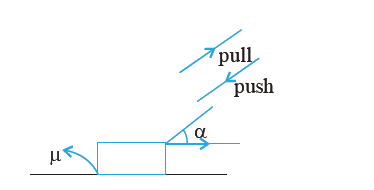A mass of 10 kg is at a point A on a table. It is moved to a point B. If the line joining A and B is horizontal, what is the work done on the object by the gravitational force ? Explain your answer.
The correct Answer is:Zero
To find the work done on the object by the gravitational force when it is moved horizontally from point A to point B, we can follow these steps:
1. Identify the Forces Acting on the Object:
The gravitational force acting on the object is given by the weight of the object, which can be calculated using the formula:
Fg=m⋅g
where m=10kg and g≈9.81m/s2.
2. Calculate the Gravitational Force:
Fg=10kg⋅9.81m/s2=98.1N
This force acts downward.
3. Determine the Displacement:
The object is moved horizontally from point A to point B. Therefore, the displacement vector →d is horizontal.
4. Find the Angle Between the Force and Displacement:
The angle θ between the gravitational force (which acts downward) and the displacement (which is horizontal) is 90∘.
5. Use the Work Formula:
The work done W by a force is given by the formula:
W=F⋅d⋅cos(θ)
In this case, since θ=90∘:
cos(90∘)=0
6. Calculate the Work Done:
Substituting the values into the work formula:
W=Fg⋅d⋅cos(90∘)=98.1N⋅d⋅0=0
Therefore, the work done by the gravitational force when moving the object horizontally is:
W=0J
Conclusion:
The work done on the object by the gravitational force while moving it horizontally from point A to point B is 0 Joules.
The gravitational force acting on the object is given by the weight of the object, which can be calculated using the formula:
Fg=m⋅g
where m=10kg and g≈9.81m/s2.
Fg=10kg⋅9.81m/s2=98.1N
This force acts downward.
The object is moved horizontally from point A to point B. Therefore, the displacement vector →d is horizontal.
The angle θ between the gravitational force (which acts downward) and the displacement (which is horizontal) is 90∘.
The work done W by a force is given by the formula:
W=F⋅d⋅cos(θ)
In this case, since θ=90∘:
cos(90∘)=0
Substituting the values into the work formula:
W=Fg⋅d⋅cos(90∘)=98.1N⋅d⋅0=0
Therefore, the work done by the gravitational force when moving the object horizontally is:
W=0J
The work done on the object by the gravitational force while moving it horizontally from point A to point B is 0 Joules.
Topper's Solved these Questions
Similar Questions
Knowledge Check
A body is being raised to a height h from the surface of earth. What is the sign of work done by
(a) applied force (b) gravitational force ?APositive, PositiveBPositive, NegativeCNegative, PositiveDNegative, Negative
An object thrown at a certain angle to the ground moves in a curved path and falls back to the ground. The initial and the final points of the path object lie on the same horizontal line. What is the work done by the force of gravity on the object ?
View SolutionA particle of mass 1kg is kept on the surface of a uniform sphere of mass 20kg and radius 1.0m. Find the work to be done against the gravitational force between them to take the particle away from the sphere.
View SolutionA horizontal force of 20 N is applied to a block of mass 4 kg resting on a rough horizontal table. If the block does not move on the table, how much frictional force the table is applying on the block. What can be said about the coefficient of static friction between the block and the table? Takeg=10ms2.
View SolutionA particle of mass 100 g is kept on the surface of a uniform sphere of mass 10 kg and radius 10 cm. Find the work to be done against the gravitational force between them to take the particle away from the sphere.
View SolutionA body of mass 0.3kg is taken up an inclined plane of length 10m and height 5m, and then allowed to slide down to the bottom again. The coefficient of friction between the body and the plane is 0.15. What is the
(a) work done by the gravitational force over the round trip.
(b) work done by the applied force over the upward journey
(c ) work done by frictional force over the round trip.
(d) kinetic energy of the body at the end of the trip.
How is the answer (d) related to the first three answers ?
m=0.3kg, OA=10m, BA=5m
View SolutionAn object is pushed and pulled along a certain angle with respect to horizontal and is moved the some distance on the ground. Now the work done by frictional force will be more in

View SolutionA car of mass 1000kg moves from point A to B. If kinetic energy of car at point A is 100KJ and at B is 220Kj. Then find work done by friction force on the car ?

View Solution
